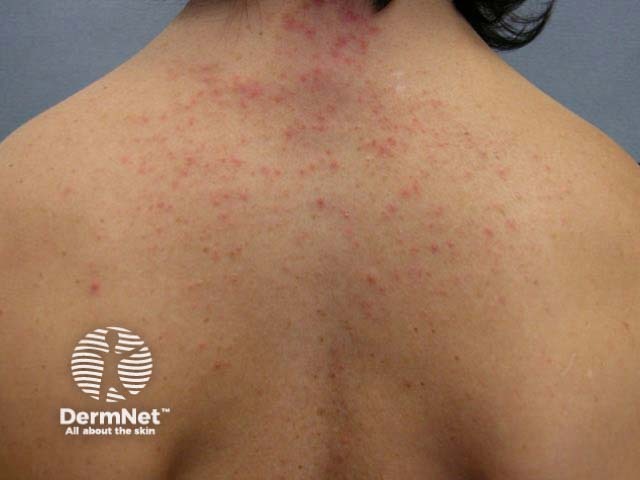Main menu
Common skin conditions

NEWS
Join DermNet PRO
Read more
Quick links
This quiz involves skin conditions similar to acne i.e. there are follicular papules and pustules. At times they may be difficult to distinguish from each other and from acne. Swabs and skin scrapings for microscopy, bacterial and fungal culture may aid diagnosis.
Acneiform eruptions may affect the face and neck. Acneiform eruptions on trunk are described as folliculitis, which may be due to infection, obstruction, or unknown irritant factors. Time course, distribution and appearance may be helpful in making a more accurate diagnosis.
Superficial staphylococcal folliculitis is often accompanied by deeper furunculosis (boils) and abscesses. Individual lesions are acute, tender, follicular pustules. Staphylococcal follicular pustules may also be seen in wound infections. In contrast, pustules accompanying impetigo are non-follicular and less symptomatic. Mild infections resolve without treatment, but topical antiseptics / antibiotics or oral flucloxacillin may be required for more troublesome infection. The quiz describes non-staphylococcal folliculitis.
For each of the twelve cases, study the image(s) and then answer the questions. You can click on the image to view a larger version if required.
Each case should take approximately 2 minutes to complete. There is a list of suggested further reading material at the end of the quiz.

Name the acne-like eruption
Malassezia folliculitis
Describe the condition
Chronic folliculitis may be due to follicular colonisation by Malassezia yeasts. Malassezia folliculitis (formerly known as pityrosporum folliculitis) affects the upper trunk resulting in an eruption of itchy superficial papulopustules. It may accompany acne, and tends to become more prominent when this is treated with tetracyclines. Malassezia folliculitis may also accompany seborrhoeic dermatitis, especially when this is treated with topical steroids. Swabs and scrapings may fail to confirm this diagnosis, as the organism can be difficult to identify and culture.
Malassezia folliculitis tends to more prominent in warm or humid conditions, and is made worse by the application of occlusive emollients and sunscreens. So-called steroid acne is actually malassezia folliculitis precipitated by potent topical or systemic corticosteroids. The lack of comedones and monomorphous morphology are clues.
Neonatal cephalic pustulosis (also known as neonatal acne) is an acne-like eruption seen in newborns also caused by malassezia infection.